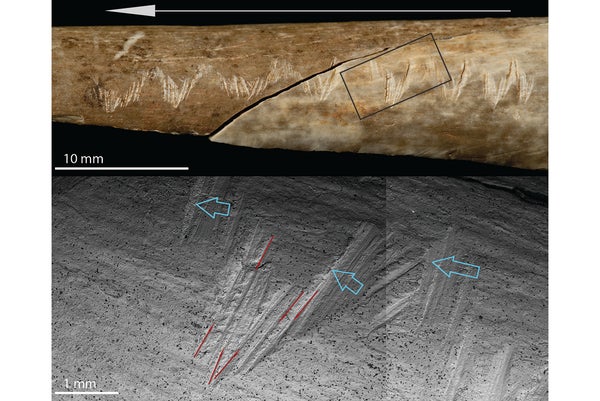Some early humans likely ate their relatives’ remains—not with ferocious contempt like some imagine, but rather with a touch of ceremony. And anthropologist Silvia Bello may have found the arm bone to prove it.
The engraved limb could stand as the oldest evidence of humans engaging in ritual cannibalism, as Bello and her fellow Natural History Museum of London researchers reported today in PLOS ONE. The study is the latest in a series of examinations Bello has made of human remains from a cave in southwestern England that, all together, suggest our early ancestors engaged in complex and unusual eating habits.
“This radius [forearm bone] has always been a bit of a mystery,” Bello says. It belongs to one of six individuals who died of unknown causes, were apparently cannibalized and whose remains were left jumbled up with animal bones roughly 14,000 years ago. Some appendages bear marks—tooth imprints and cuts from shaving off meat—that betrayed the diners’ identity. The most famous of these remains were three skulls showcasing such efficient flesh removal and bone-edge dulling that Bello refers to them as skull “cups.” The scratches on this new radius, however, are different. Bello decided to formally investigate the cuts—a zigzag pattern of crosshatches down the length of the bone—after a former museum employee suggested they might have been carved on purpose.
On supporting science journalism
If you're enjoying this article, consider supporting our award-winning journalism by subscribing. By purchasing a subscription you are helping to ensure the future of impactful stories about the discoveries and ideas shaping our world today.
To probe further, Bello and her colleagues examined the remains using two types of microscopy: scanning electron and focus variation microscopy. By taking a series of photos of the bone at different proximities and stitching all the images together, Bello explains, the tools provided a larger 3-D rendering that she examined for cut length, depth and width. With this closer look, Bello identified 87 different scrapes, single strikes or back and forth, saw like cuts. As a Paleolithic person would likely have known, she explains, skimming meat off a body is best executed when making as little contact with the bone as possible, because bone dulls stone tools. With hard materials and an increasingly blunt knife, carving takes significant muscle power. So finding cuts on the bone suggests that “they wanted those engravings to be seen,” Bello says.
The carver even put off the most succulent part of the meal—bone marrow—in order to finish the pattern. More nutritious than muscle, marrow becomes accessible when the radius is cracked in two. The way the chevron pattern continues from one half to the other indicates it was etched when the bone was still one piece, Bello says. If someone were digging into a body only for a good meal, they would not have stopped to decorate the casing on its best bits.
And when Bello investigated art produced on other animal bones and antlers during the same Magdalenian culture of the upper Paleolithic period and in the same region, she found the dominantly used patterns to be zigzags and chevrons. Compared with her radius, “the similarity was quite striking,” she says.
Is it fair to interpret time-consuming art that delays a meal as ceremonial behavior? To Pat Shipman, it is. “I’m absolutely sure they’re right,” says the retired adjunct professor at The Pennsylvania State University, who helped pioneer the use of 3-D microscopy for bone mark analysis and was not involved in the work. And Shipman does not use the term “ceremonial” lightly. When she was entering the field in the 1970s, she says, anthropologists chucked anything they struggled to understand into the “ritual” bin. With technology like the electron microscope, the science behind artifact analysis has become more thorough and evidence-based. “I would be surprised if [Bello’s conclusion] was overturned by later evidence,” Shipman says.
Hélène Rougier does not share Shipman’s assurance. The California State University, Northridge, anthropologist says the similarities between the incisions and known art from the era as well as the fact that the engraver was aware they were consuming and decorating another human, make interpreting the cuts as ceremonial behavior tempting. “But other hypotheses cannot be definitely dismissed,” she wrote in an e-mail. For instance, the carving might have been a spur-of-the-moment decision, she says. Maybe the arm bone was actually engraved for functionality, not as a ritual, suggests Paul Pettitt, an archaeologist at Durham University in England. With the pointy tip such a fractured fragment would likely produce, this bone might have been used to puncture other materials. If so, “certainly these would have been used in tasks that were somewhat messy,” he says. Like grooves on a bike handle, deep carvings enhance grip. And because Bello compared her bone with animal bones and antlers that also have been interpreted as tools, this possibility cannot be ruled out, he notes.
In future endeavors Bello plans to work with the museum’s DNA lab to see if the bones belonged to individuals who were related or if the skulls they found were from the same bodies. Bello also wants the public to gain a new perspective on historic cannibalism. Other renditions of ritualized cannibalism live on in places like Papua New Guinea. But for many cultures, the thought of eating another human repulses us so greatly; it can be hard to imagine our ancestors might have consumed a relative out of respect, she says. “It is so different from what we do, we struggle to accept it as a possible scenario.” This idea may be more palatable now that Bello can hold up a bone that might bear evidence.
